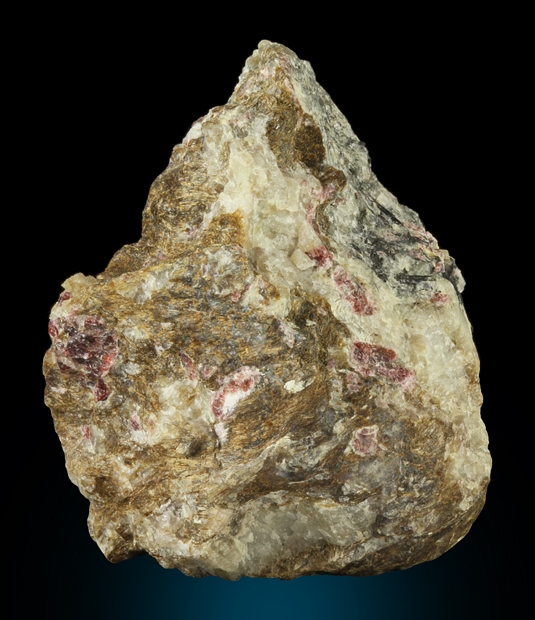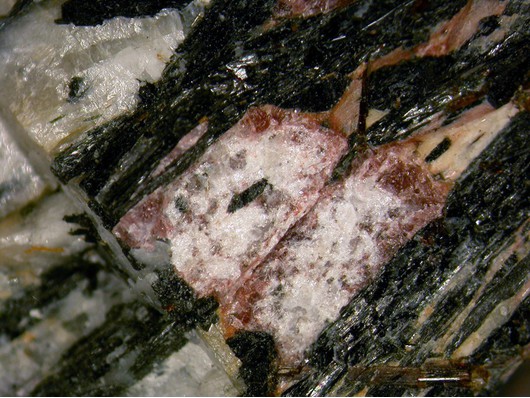Paraumbite
A valid IMA mineral species
This page is currently not sponsored. Click here to sponsor this page.
About Paraumbite
Formula:
K3Zr2H(Si3O9)2 · nH2O
Colour:
Colorless to white, gray, pale green
Lustre:
Vitreous, Pearly
Hardness:
4½
Specific Gravity:
2.59
Crystal System:
Orthorhombic
Name:
Name derives from the Greek 'para' for near, and umbite, for the close structural similarity to that mineral.
Type Locality:
This page provides mineralogical data about Paraumbite.
Unique Identifiers
Mindat ID:
3117
Long-form identifier:
mindat:1:1:3117:8
GUID
(UUID V4):
(UUID V4):
fcb1979d-db72-4912-8bb1-87d7b3d90455
IMA Classification of Paraumbite
Approved
IMA Formula:
K3Zr2H(Si3O9)2 · 3H2O
First published:
1983
Classification of Paraumbite
9.DG.25
9 : SILICATES (Germanates)
D : Inosilicates
G : Inosilicates with 3-periodic single and multiple chains
9 : SILICATES (Germanates)
D : Inosilicates
G : Inosilicates with 3-periodic single and multiple chains
59.2.1.2
59 : CYCLOSILICATES Three-Membered Rings
2 : Three-Membered Rings, hydrated
59 : CYCLOSILICATES Three-Membered Rings
2 : Three-Membered Rings, hydrated
14.10.17
14 : Silicates not Containing Aluminum
10 : Silicates of Zr or Hf
14 : Silicates not Containing Aluminum
10 : Silicates of Zr or Hf
Mineral Symbols
As of 2021 there are now IMA–CNMNC approved mineral symbols (abbreviations) for each mineral species, useful for tables and diagrams.
| Symbol | Source | Reference |
|---|---|---|
| Pumb | IMA–CNMNC | Warr, L.N. (2021). IMA–CNMNC approved mineral symbols. Mineralogical Magazine, 85(3), 291-320. doi:10.1180/mgm.2021.43 |
Physical Properties of Paraumbite
Vitreous, Pearly
Transparency:
Transparent, Translucent
Comment:
pearly on cleavages.
Colour:
Colorless to white, gray, pale green
Streak:
white
Hardness:
4½ on Mohs scale
Hardness:
VHN100=280 - 504 - Vickers
Cleavage:
Perfect
(010) micaceous, (100) and {110}, less perfect
(010) micaceous, (100) and {110}, less perfect
Fracture:
Irregular/Uneven
Density:
2.59 g/cm3 (Measured) 2.92 g/cm3 (Calculated)
Optical Data of Paraumbite
Type:
Biaxial (-)
RI values:
nα = 1.588(2) nβ = 1.601(2) nγ = 1.610(2)
2V:
Measured: 82° , Calculated: 78°
Max Birefringence:
δ = 0.022

Image shows birefringence interference colour range (at 30µm thickness)
and does not take into account mineral colouration.
and does not take into account mineral colouration.
Surface Relief:
Moderate
Dispersion:
relatively strong
Chemistry of Paraumbite
Mindat Formula:
K3Zr2H(Si3O9)2 · nH2O
Common Impurities:
Ti,Hf,Fe,Na,K
Crystallography of Paraumbite
Crystal System:
Orthorhombic
Class (H-M):
mm2 - Pyramidal
Cell Parameters:
a = 10.36(2) Å, b = 13.27(2) Å, c = 14.56(1) Å
Ratio:
a:b:c = 0.781 : 1 : 1.097
Unit Cell V:
2,001.67 ų (Calculated from Unit Cell)
Z:
4
Comment:
Space Group: P2cm:
X-Ray Powder Diffraction
Powder Diffraction Data:
| d-spacing | Intensity |
|---|---|
| 6.46 Å | (80) |
| 5.95 Å | (100) |
| 3.34 Å | (70) |
| 3.01 Å | (90) |
| 2.90 Å | (70) |
| 2.56 Å | (60) |
Geological Environment
Paragenetic Mode(s):
| Paragenetic Mode | Earliest Age (Ga) |
|---|---|
| Stage 3a: Earth’s earliest Hadean crust | >4.50 |
| 9 : Lava/xenolith minerals (hornfels, sanidinite facies) | |
| Near-surface Processes | |
| 22 : Hydration and low-𝑇 subsurface aqueous alteration (see also #23) | |
| Stage 4b: Highly evolved igneous rocks | >3.0 |
| 35 : Ultra-alkali and agpaitic igneous rocks |
Type Occurrence of Paraumbite
General Appearance of Type Material:
Equant crystals, to 1 mm; massive.
Place of Conservation of Type Material:
Geology Museum, Kola Branch, Academy of Sciences, Apatity, Russia, 5842, 5843.
Mineralogical Museum, St. Petersburg University, St. Petersburg, Russia, 17065.
Mining Institute, St. Petersburg, Russia, 1630/1.
Il'menskii Preserve Museum, Miass, Russia, 13095vr.
A.E. Fersman Mineralogical Museum, Academy of Sciences, Moscow, Russia, 82760, vis3464, vis4544, vis4545, vis5045.
Mineralogical Museum, St. Petersburg University, St. Petersburg, Russia, 17065.
Mining Institute, St. Petersburg, Russia, 1630/1.
Il'menskii Preserve Museum, Miass, Russia, 13095vr.
A.E. Fersman Mineralogical Museum, Academy of Sciences, Moscow, Russia, 82760, vis3464, vis4544, vis4545, vis5045.
Geological Setting of Type Material:
Replacing wadeite in a pegmatite in a differentiated alkalic massif.
Associated Minerals at Type Locality:
Reference:
Khomyakov, A.P., Voronkov, A.A., Kobyashev, Y.S., Polezhaeva, L.I. (1983) Umbite and paraumbite, new potassium zirconosilicates from the Khibina alkali massif. Zapiski Vsesoyuznogo Mineralogicheskogo Obshchestva: 112: 461 469 (Russian).
Synonyms of Paraumbite
Other Language Names for Paraumbite
German:Paraumbit
Spanish:Paraumbita
Common Associates
Associated Minerals Based on Photo Data:
Related Minerals - Strunz-mindat Grouping
| 9.DG. | Calcinaksite | KNaCa(Si4O10) · H2O |
| 9.DG. | Barrydawsonite-(Y) | Na1.5Y0.5CaSi3O8(OH) |
| 9.DG. | Paratobermorite | Ca4(Al0.5Si0.5)2Si4O16(OH)(H2O)2 · (Ca · 3H2O) |
| 9.DG. | Enricofrancoite | KNaCaSi4O10 |
| 9.DG. | Alvesite | NaKZrSi6O15 · 2H2O |
| 9.DG.02 | Steedeite | NaMn2[Si3BO9](OH)2 |
| 9.DG.02 | Nolzeite | NaMn2[Si3BO9](OH)2 · 2H2O |
| 9.DG.05 | Bustamite | CaMn2+(Si2O6) |
| 9.DG.05 | Ferrobustamite | CaFe2+(Si2O6) |
| 9.DG.05 | Pectolite | NaCa2Si3O8(OH) |
| 9.DG.05 | Serandite | NaMn2+2Si3O8(OH) |
| 9.DG.05 | Wollastonite | Ca3(Si3O9) |
| 9.DG.05 | Wollastonite-1A | CaSiO3 |
| 9.DG.05 | Tanohataite | LiMn2Si3O8(OH) |
| 9.DG.05 | Schizolite | NaCaMnSi3O8(OH) |
| 9.DG.05 | Murakamiite | LiCa2Si3O8(OH) |
| 9.DG.05 | Dalnegorskite | Ca5Mn(Si3O9)2 |
| 9.DG.07 | Cascandite | CaScSi3O8(OH) |
| 9.DG.08 | Plombièrite | [Ca4Si6O16(OH)2 · 2H2O] · (Ca · 5H2O) |
| 9.DG.10 | Clinotobermorite | [Ca4Si6O17 · 2H2O] · (Ca · 3H2O) |
| 9.DG.10 | Riversideite | Ca5(HSi3O9)2 · 2H2O |
| 9.DG.10 | Tobermorite | Ca4Si6O17(H2O)2 · (Ca · 3H2O) |
| 9.DG.12 | Jusite | Na2Ca15Al4Si16O54 · 17H2O |
| 9.DG.12 | Kenotobermorite | Ca4Si6O15(OH)2(H2O)2 · 3H2O |
| 9.DG.15 | Foshagite | Ca4(Si3O9)(OH)2 |
| 9.DG.20 | Jennite | Ca9(Si3O9)2(OH)8 · 8H2O |
| 9.DG.20 | Kamenevite | K2TiSi3O9 · H2O |
| 9.DG.25 | Umbite | K2(Zr,Ti)Si3O9 · H2O |
| 9.DG.30 | Sørensenite | Na4SnBe2Si6O16(OH)4 |
| 9.DG.32 | Escheite | Ca2NaMnTi5[Si12O34]O2(OH)3 · 12H2O |
| 9.DG.35 | Xonotlite | Ca6(Si6O17)(OH)2 |
| 9.DG.40 | Hillebrandite | Ca2(SiO3)(OH)2 |
| 9.DG.45 | Zorite | Na8(Ti,Nb)5(Si6O17)2(OH,O)5 · 14H2O |
| 9.DG.45 | Chivruaiite | Ca4(Ti,Nb)5(Si6O17)2(OH,O)5 · 13-14H2O |
| 9.DG.50 | Haineaultite | (Na,Ca)5Ca(Ti,Nb)5(Si6O17)2(OH,F)8 · 5H2O |
| 9.DG.55 | Epididymite | Na2Be2Si6O15 · H2O |
| 9.DG.60 | Eudidymite | Na2Be2Si6O15 · H2O |
| 9.DG.65 | Elpidite | Na2ZrSi6O15 · 3H2O |
| 9.DG.65 | Patynite | NaKCa4[Si9O23] |
| 9.DG.67 | Whelanite | Cu2+2Ca6[Si6O17(OH)](CO3)(OH)3 · 2H2O |
| 9.DG.70 | Fenaksite | (K,Na)4(Fe,Mn)2(Si4O10)2(OH,F) |
| 9.DG.70 | Litidionite | CuNaKSi4O10 |
| 9.DG.70 | Manaksite | KNaMnSi4O10 |
| 9.DG.70 | Yusupovite | Na2Zr(Si6O15) · 2.5H2O |
| 9.DG.75 | Tinaksite | K2Na(Ca,Mn2+)2TiO[Si7O18(OH)] |
| 9.DG.75 | Tokkoite | K2Ca4[Si7O18(OH)](OH,F) |
| 9.DG.75 | Senkevichite | CsKNaCa2TiO[Si7O18](OH) |
| 9.DG.80 | Canasite | K3Na3Ca5Si12O30(OH)4 |
| 9.DG.80 | Fluorcanasite | K3Na3Ca5Si12O30F4 · H2O |
| 9.DG.85 | Miserite | K1.5-x(Ca,Y,REE)5(Si6O15)(Si2O7)(OH,F)2 · yH2O |
| 9.DG.90 | Frankamenite | K3Na3Ca5(Si12O30)(F,OH)4 · H2O |
| 9.DG.92 | Charoite | (K,Sr)15-16(Ca,Na)32[Si6O11(O,OH)6]2[Si12O18(O,OH)12]2[Si17O25(O,OH)18]2(OH,F)4 · ~3H2O |
| 9.DG.95 | Yuksporite | K4(Ca,Na)14(Sr,Ba)2(◻,Mn,Fe)(Ti,Nb)4(O,OH)4(Si6O17)2(Si2O7)3(H2O,OH)3 |
| 9.DG.97 | Eveslogite | (Na,K,Ca,Sr,Ba)48 [(Ti,Nb,Mn,Fe2+)12Si48O144(OH)12](F,OH,Cl)14 |
Other Information
Health Risks:
No information on health risks for this material has been entered into the database. You should always treat mineral specimens with care.
Internet Links for Paraumbite
mindat.org URL:
https://www.mindat.org/min-3117.html
Please feel free to link to this page.
Please feel free to link to this page.
Search Engines:
External Links:
References for Paraumbite
Reference List:
Localities for Paraumbite
Locality List
 - This locality has map coordinates listed.
- This locality has map coordinates listed.
 - This locality has estimated coordinates.
ⓘ - Click for references and further information on this occurrence.
? - Indicates mineral may be doubtful at this locality.
- This locality has estimated coordinates.
ⓘ - Click for references and further information on this occurrence.
? - Indicates mineral may be doubtful at this locality.
 - Good crystals or important locality for species.
- Good crystals or important locality for species.
 - World class for species or very significant.
(TL) - Type Locality for a valid mineral species.
(FRL) - First Recorded Locality for everything else (eg varieties).
- World class for species or very significant.
(TL) - Type Locality for a valid mineral species.
(FRL) - First Recorded Locality for everything else (eg varieties).
All localities listed without proper references should be considered as questionable.
Canada | |
| |
Russia (TL) | |
| |
USA | |
|
Quick NavTopAbout ParaumbiteUnique IdentifiersIMA Classification Classification Mineral SymbolsPhysical Properties Optical Data Chemistry Crystallography X-Ray Powder DiffractionGeological EnvironmentType Occurrence SynonymsOther LanguagesCommon AssociatesStrunz-MindatOther InformationInternet Links References Localities Locality List







 symbol to view information about a locality.
The
symbol to view information about a locality.
The 



Wadeite point, Eveslogchorr Mt, Khibiny Massif, Murmansk Oblast, Russia